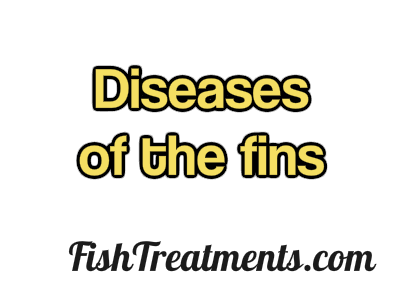
Split fins should be left alone, for the most part. People ‘get busy’ with lightweight suture material and super-glue and that’s FINE, there are even successes with that but then, there are also complications like MORE fin splitting and infections. Most fin lesions between the rays will heal and close. Mother Nature is amazing.
Rotting Fins is simply a bacterial infection eating away at the fins of a fish. MANY people will ‘trim away’ the diseased part of the fin. I like the cosmetics of that repair, it takes the fin “back to healthy tissue” and sets the fish up for success – HOWEVER it seems like it would hurt? Do fish feel pain? Many say that they do. Could it hurt more than a rotting fin? Probably not. Rotting fins are treated with a better environment, assessed by testing, and a decent 78 DF environment, plus antimicrobials.
Broken Rays In Fins can be handled with ‘benign neglect’ unless infection starts. VERY often the broken ray will ‘die’ and the piece of the ray that has lost it’s main blood supply may die and slough out. If you’re fighting infection in a fin, then the following may be useful.
Antibiotic baths are probably the best way to handle fin rot in smaller, aquarium fish. A lot of the following table helps people with treatments for fin rot in PONDS and larger facilities as well. For aquarists, a favorable look should be taken at Tetra’s Life Guard halamine product.
Bacterial Infections in Koi and Pond Fish | |
If you can't catch the fish and they have ulcers, consider serial treatments with potassium permanganate. This is especially good in cooler water, has a spectrum against ciliates like Costia and Chilodonella and may even destroy Fluke infestations. Dosing is better described elsewhere. See notes. | |
If you CAN catch the fish, consider injections of antibiotics for the valuable ones, iodine swabs on open wounds, and then water treatments (See remainder of this table) for uncatchable infected swimmers. | |
Scrubbing / debriding wounds in Koi depends on being able to "get through" slime and removing dead scales and NONWOVEN gauze is too slick. You need "Woven" gauze. Believe it or not, for HUMAN wounds it's undesirable. So it's CHEAPPPPPP. | |
Treatment with chloramine-T is potentially dangerous in the case of overdose. Dosing is beyond the scope of fish treatments website. If you're not sure about instructions in Dr Jill Spangenberg's notes, this might not be for you. | |
Antibiotic Baths | |
Soft rubber tanks | |
Aeration in the holding / bath tank | |
In holding, these sponge filters are soft on the Koi faces, (won't pick up eggs or fry) and they provide filtration AND aeration in one unit. They're cost-effective they BIOSEED very quickly. If you're using Lifeguard as a bath, forget bioseeding ha ha ha ha ain't no germ gonna live in the filter. Still, a soft, smushy 'airstone' is necessary. | |
Medicated Food | |
Oxolinic acid and Naladixic acid are antimicrobials related to the quinolone antibiotics. They're 'forgiving' on dosage when mixed with oil, or other binder to put on food. | |
Confectioner's Glaze | |
There is no contest between all of the above and injections of antibiotics. If the fish are valuable and you want top-notch results, you need to be injecting the fish with legitimate antibiotics from a prescribing veterinarian. | |